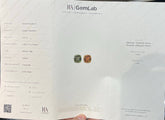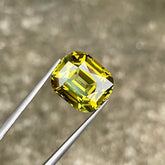Discovering Diversity: The 9 Colors of Tourmaline
Tourmaline is a mesmerizing gemstone known for its diverse range of colors. In this comprehensive blog post, discover the stunning variety of tourmaline hues, from the fiery red rubellite to the serene green verdelite. Dive into the world of tourmaline and learn about the unique properties and meanings associated with each color. Whether you're a gemstone enthusiast or simply curious about the wonders of nature, this blog post will illuminate the vibrant spectrum of tourmaline colors.
9 Different Colors Of Tourmaline
Tourmaline is a gemstone that captivates with its kaleidoscope of colors. Unlike many other gemstones that are known for one dominant hue, tourmaline offers a spectrum of shades that can rival a painter's palette. Its name, derived from the Sinhalese word "turamali," means "mixed colors," and rightly so. In this exploration of tourmaline, we'll take you through nine enchanting colors of this gemstone, each with its unique characteristics and allure.

1. Red Tourmaline (Rubellite):
We begin our tour with the passionate and fiery red tourmaline, known as rubellite. This vibrant gemstone ranges from deep crimson to bright pink, often resembling the allure of a ruby. Rubellite is associated with love, passion, and courage, making it a favorite choice for romantic jewelry.

2. Green Tourmaline (Verdelite):
Green tourmaline, or verdelite, is a symbol of vitality, growth, and abundance. Its shades vary from pale mint to deep forest green, making it a beloved gemstone for nature-inspired jewelry. Green tourmaline is believed to promote harmony and emotional balance.

3. Blue Tourmaline (Indicolite):
Indicolite, the blue tourmaline, evokes the tranquil depths of the ocean. Ranging from light sky blue to deep sapphire, this gemstone embodies serenity and clarity. Indicolite is thought to enhance communication and self-expression.

4. Pink Tourmaline:
Pink tourmaline, sometimes called "rose tourmaline," showcases delicate shades of pink, from soft pastel to vivid magenta. This gemstone is associated with love, compassion, and emotional healing. It's a popular choice for engagement rings and heartwarming gifts.

5. Watermelon Tourmaline:
Nature's artistry is on full display with watermelon tourmaline. This unique gemstone displays a combination of pink and green in a single crystal, resembling the colors of a watermelon. It symbolizes balance and harmony, making it a cherished choice for holistic jewelry.

6. Multicolored Tourmaline:
Multicolored tourmaline, often referred to as "tourmaline rainbow," displays a mesmerizing array of colors within a single gemstone. It represents diversity, creativity, and unity, making it a symbol of harmony and acceptance.

7. Black Tourmaline (Schorl):
In stark contrast to its colorful counterparts, black tourmaline, or schorl, is known for its deep black hue. It is a powerful protective stone, believed to ward off negative energies and enhance grounding and stability.

8. Brown Tourmaline (Dravite):
Brown tourmaline, or dravite, is reminiscent of the earth's rich soil and brings a sense of warmth and comfort. This gemstone is associated with self-acceptance, emotional healing, and stability.
9. Yellow Tourmaline (Canary Tourmaline):
Yellow tourmaline, also known as canary tourmaline, shines like a ray of sunshine. Its golden hues symbolize joy, optimism, and personal power. Yellow tourmaline is believed to boost self-confidence and creativity.

How a Mineral Becomes a Gemstone
Gemstones have a timeless allure, captivating us with their beauty, rarity, and mystique. But have you ever wondered how a mineral transforms into a coveted gemstone? The journey from a rough, unremarkable rock to a dazzling jewel is a fascinating one, involving a combination of geological processes, human intervention, and the inherent qualities of the mineral itself. In this exploration, we'll uncover the remarkable journey of how a mineral becomes a gemstone.
1. Formation in the Earth's Crust:
The journey of a gemstone begins deep within the Earth's crust. Most gemstones are minerals, which are naturally occurring, inorganic substances with a specific chemical composition and atomic structure. These minerals form under intense geological conditions, often deep within the Earth's mantle.
2. Heat and Pressure:
Gemstone-forming minerals are subjected to extreme heat and pressure over millions of years. These conditions cause the minerals to crystallize, forming distinct crystal structures that give rise to the gem's unique properties. For example, diamonds, the hardest gemstone, form under extreme pressure and heat deep within the Earth.
3. Growth and Transformation:
As minerals crystallize, they may incorporate trace elements or impurities that impart color or other distinctive characteristics to the gemstone. For instance, the presence of chromium gives emeralds their vibrant green color, while iron and titanium create the blue hues in sapphires.
4. Uplift and Erosion:
Over geological time scales, tectonic forces and natural processes uplift these gem-bearing rocks closer to the Earth's surface. Erosion and weathering then expose these minerals, allowing them to be discovered by prospectors or collectors.
5. Discovery and Mining:
The journey of a gemstone transitions from geological processes to human hands when miners and geologists identify potential gem-bearing rocks and deposits. Mining operations are established to extract these rough gemstones from the Earth. Some gemstones, like diamonds, may also be found in riverbeds, brought to the surface by volcanic activity in the past.
6. Sorting and Grading:
Once extracted, the rough gemstones are sorted, cleaned, and graded. Gemologists and experts assess various factors like color, clarity, cut, and carat weight to determine the gem's quality and value. High-quality gemstones are cut and polished to bring out their best characteristics.
7. Cutting and Polishing:
This is a crucial step in the transformation of a rough mineral into a dazzling gemstone. Skilled lapidaries use precision tools to cut and shape the gemstone, revealing its innate beauty. The angles and facets of the cut are carefully calculated to maximize the gem's brilliance and sparkle.
8. Setting in Jewelry:
Many gemstones find their ultimate destiny as centerpieces in exquisite jewelry designs. Jewelers create settings and mount the cut gemstones in rings, necklaces, earrings, and other adornments, enhancing their allure and commercial value.
9. Gracing the World:
Once set in jewelry, gemstones are ready to grace the world. They become symbols of love, luxury, and personal expression. People wear gemstone jewelry for various reasons, including celebrations, rituals, and as heirlooms passed down through generations.
The transformation of a mineral into a gemstone is a remarkable journey that spans geological epochs and human craftsmanship. From the depths of the Earth's crust to the hands of miners, gemologists, lapidaries, and jewelers, each stage of the process plays a vital role in bringing forth the beauty and magic of these precious stones. Gemstones continue to captivate our imaginations, not only for their intrinsic value but also for the stories they tell about the Earth's history and the artistry of those who shape them into timeless treasures.
Conclusion:
Tourmaline's enchanting array of colors reflects the astounding diversity found in nature. From the fiery passion of rubellite to the tranquil depths of indicolite and the harmony of watermelon tourmaline, each color has its unique charm and symbolism. Whether you're drawn to tourmaline for its aesthetic beauty or its metaphysical properties, there's a shade to suit every preference.
These nine different colors of tourmaline offer a journey through emotions, elements, and energies. Whether you seek emotional healing, protection from negative forces, or simply a burst of color in your life, tourmaline has something to offer. It's no wonder that this gemstone has been cherished for centuries, adorning jewelry and serving as a symbol of diverse facets of human existence.
As you explore the world of tourmaline, remember that the true beauty of this gemstone lies not just in its colors but in the stories and meanings it carries. Whether you choose a tourmaline piece for its symbolism or simply for its visual appeal, you're sure to be captivated by the endless charm of this gemstone's colors. So, let tourmaline's hues inspire and enrich your life, one shade at a time.
FAQs
How can you tell if a stone is tourmaline?
Identifying tourmaline can be challenging due to its wide range of colors and properties. To determine if a stone is tourmaline, you can consider its color, crystal structure, and some simple tests. Tourmaline often exhibits distinctive striations on its surface, and when examined closely, it may display a triangular cross-section. Additionally, tourmaline is typically doubly refractive, meaning it can split light into two rays.
However, to be more certain, you may want to consult a professional gemologist or use gemological testing tools like a refractometer and polariscope, which can provide precise identification. These experts can evaluate the stone's physical and optical properties, as well as its chemical composition, to confirm if it is indeed tourmaline.
Is tourmaline rarer than diamonds?
Yes, tourmaline is generally considered to be rarer than diamonds. While diamonds are valued for their scarcity and high market demand, tourmaline's rarity stems from the fact that it occurs in a wide range of colors and chemical compositions. Each color and variety of tourmaline has its own level of rarity, with some colors, such as certain shades of pink and green, being particularly scarce.
Diamonds, on the other hand, are primarily valued for their rarity in the colorless or near-colorless range, and the diamond market is highly controlled to maintain scarcity and price stability. While diamonds are more commonly found in engagement rings and other fine jewelry, the wide variety of tourmaline colors and limited occurrences make certain tourmaline specimens, especially those of exceptional quality and color, more challenging to find and, in some cases, even more valuable than diamonds of similar carat weight.
What is a tourmaline stone good for?
Tourmaline is a versatile gemstone known for its various metaphysical and healing properties. It's believed to be good for:
Protection:
Black tourmaline, in particular, is often used as a protective stone, believed to ward off negative energies and electromagnetic radiation.
Emotional Balance:
Many people use tourmaline for emotional healing and balance. It's thought to help alleviate stress, anxiety, and feelings of insecurity.
Creativity:
Tourmaline is associated with enhancing creativity and inspiration, making it a favored gemstone among artists and writers.
Physical Healing:
Some believe tourmaline has physical healing properties, such as boosting the immune system, improving circulation, and reducing pain.
Chakra Alignment:
Tourmaline is associated with various chakras depending on its color. For example, pink tourmaline is linked to the heart chakra, promoting love and emotional healing, while black tourmaline is associated with the root chakra for grounding.
Spiritual Growth:
Tourmaline is used by many for spiritual growth, meditation, and deepening one's connection with the higher self.
Balance and Harmony:
Multicolored tourmaline is believed to harmonize and balance energy, helping individuals maintain equilibrium in their lives.
It's important to note that while many people find value in the metaphysical and healing properties of tourmaline, these beliefs are not scientifically proven, and the effectiveness of tourmaline in such applications may vary from person to person. If you are interested in using tourmaline for these purposes, it's recommended to consult with a qualified practitioner or healer who can provide guidance and support.















